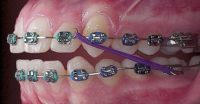Elastics (Rubberbands)
Elastics are used to generate a gentle but continuous force to help in the movement of individual teeth or in the aligning of one dental arch to the other.
Teeth never fail to move when elastics are worn consistently, as directed by the orthodontist. When elastics are worn one day and left off the next, tooth movement does not continue as rapidly, and often no change takes place. This is caused by the jiggling of the teeth back and forth within the bone, a condition which actually sets up resistance to normal movement. If you follow the instructions exactly, you will get better, faster, and more comfortable results, leading to the removal of your braces in a shorter period of time.
There is often some initial discomfort when rubber bands are first worn, but this discomfort usually disappears after one to three days. If you stop wearing the rubber bands during the periods of discomfort, slower tooth movement often results, and the discomfort will return when the elastics are replaced. Soreness in the jaw joint area, however, is abnormal, and elastics should be discontinued if any problems result in the jaw joint area. Problems can include pain, a clicking or grating sensation, and the inability to open or close the mouth. In a case of problems in the jaw joint region, discontinue the elastics and call the office.
New elastics should be used each day, as the old elastics tend to lose their elasticity with time. It is recommended to change the elastics at least every 12 hours.
Unless otherwise directed, wear your elastics 24 hours a day. You should call the office if you are having trouble getting the elastics hooked properly on the orthodontic appliances or if there is any reason you cannot wear your elastics as directed. At each appointment, check with us to see if you should continue to wear your elastics, and pick up a back-up supply if needed.



